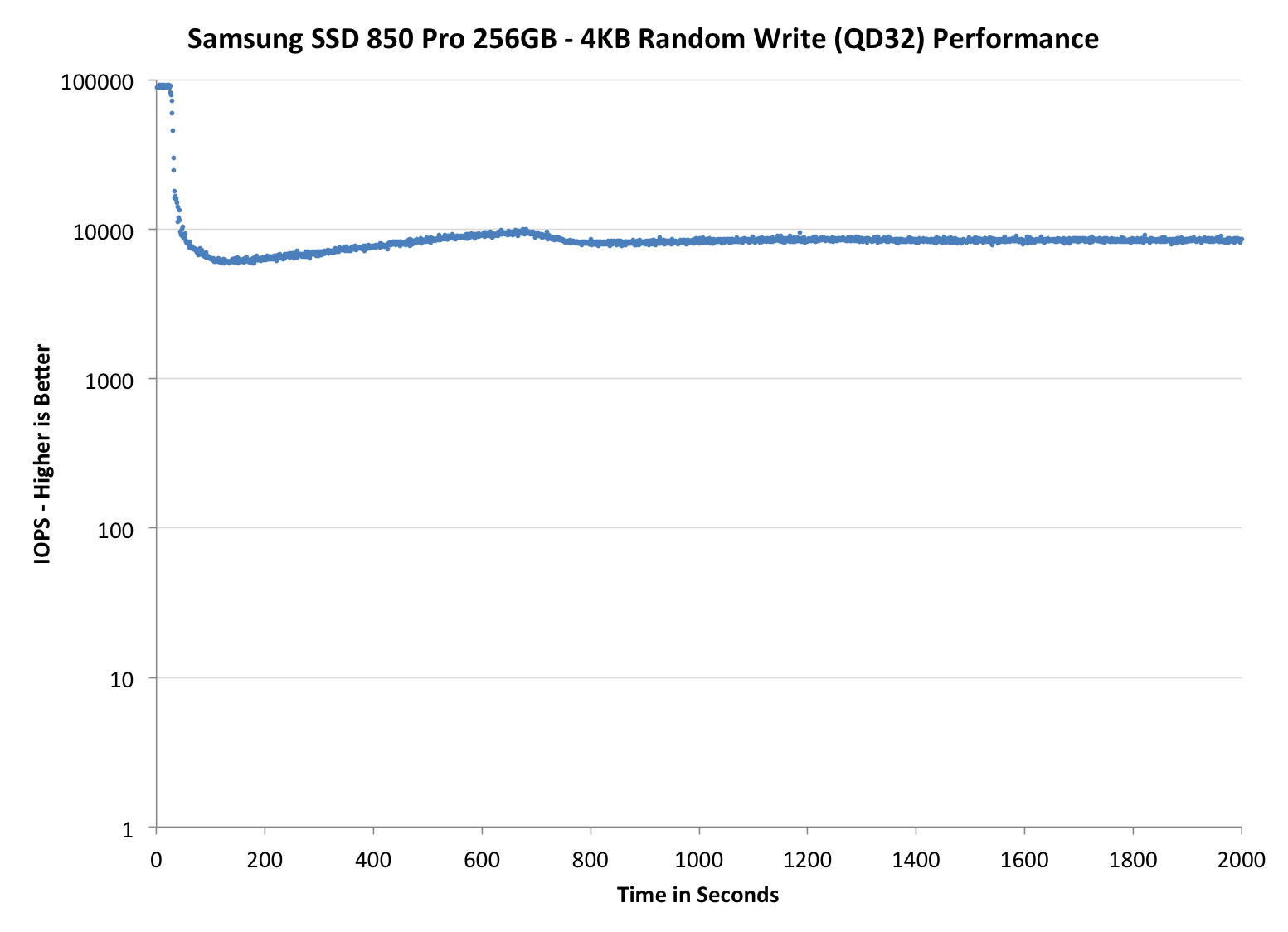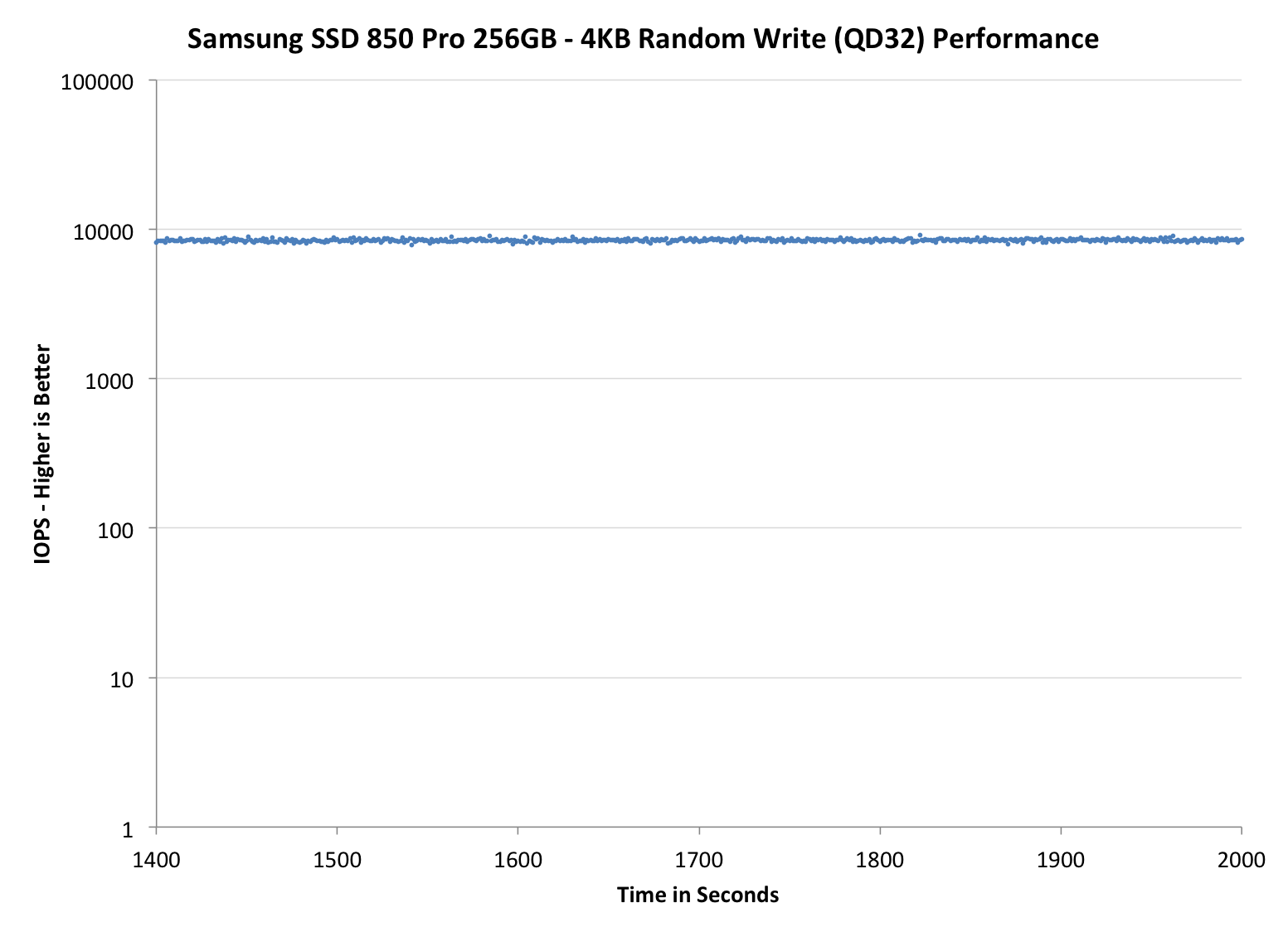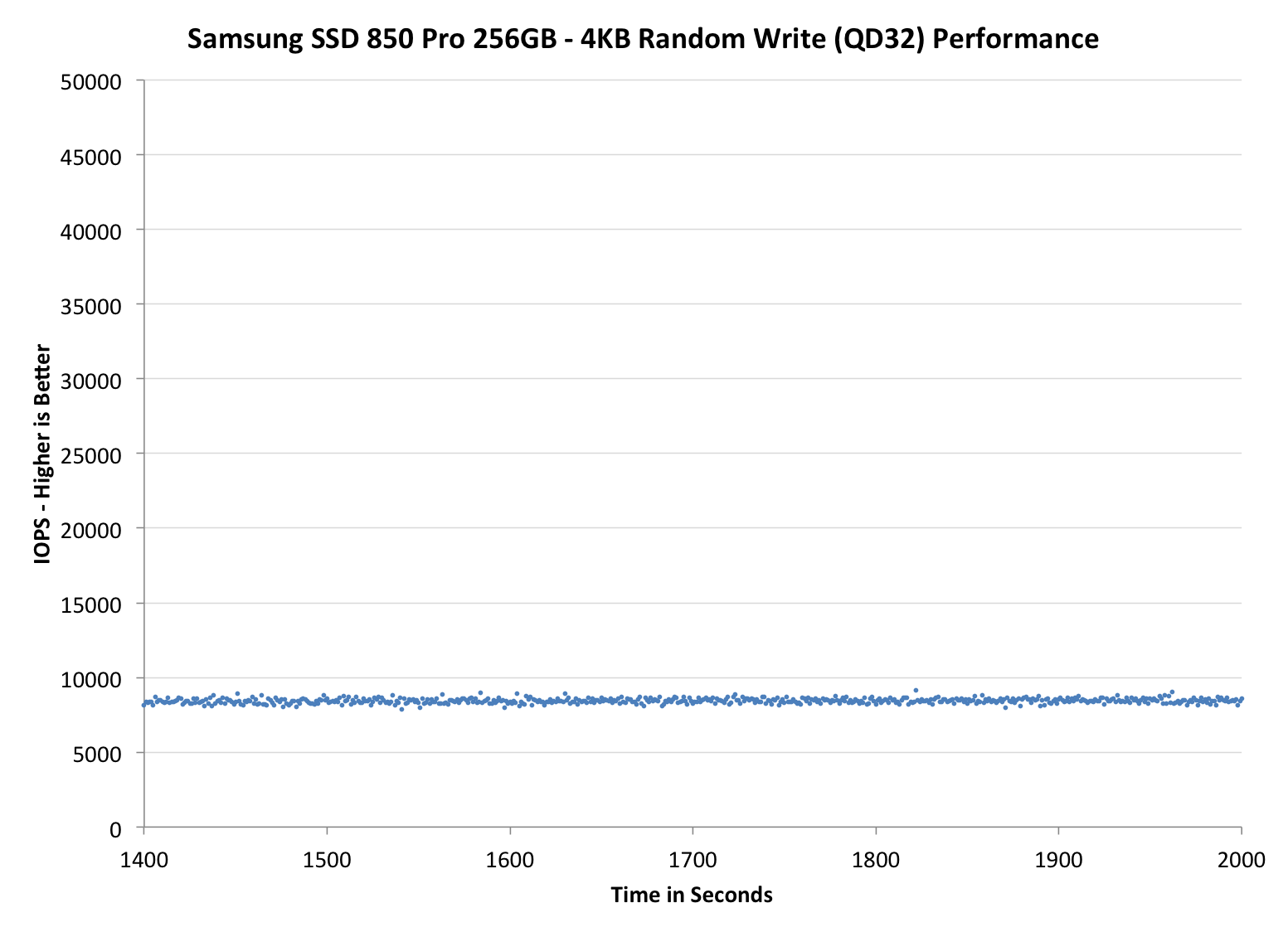Samsung SSD 850 Pro (128GB, 256GB & 1TB) Review: Enter the 3D Era
by Kristian Vättö on July 1, 2014 10:00 AM ESTPerformance Consistency
Performance consistency tells us a lot about the architecture of these SSDs and how they handle internal defragmentation. The reason we don’t have consistent IO latency with SSD is because inevitably all controllers have to do some amount of defragmentation or garbage collection in order to continue operating at high speeds. When and how an SSD decides to run its defrag or cleanup routines directly impacts the user experience as inconsistent performance results in application slowdowns.
To test IO consistency, we fill a secure erased SSD with sequential data to ensure that all user accessible LBAs have data associated with them. Next we kick off a 4KB random write workload across all LBAs at a queue depth of 32 using incompressible data. The test is run for just over half an hour and we record instantaneous IOPS every second.
We are also testing drives with added over-provisioning by limiting the LBA range. This gives us a look into the drive’s behavior with varying levels of empty space, which is frankly a more realistic approach for client workloads.
Each of the three graphs has its own purpose. The first one is of the whole duration of the test in log scale. The second and third one zoom into the beginning of steady-state operation (t=1400s) but on different scales: the second one uses log scale for easy comparison whereas the third one uses linear scale for better visualization of differences between drives. Click the buttons below each graph to switch the source data.
For more detailed description of the test and why performance consistency matters, read our original Intel SSD DC S3700 article.
 |
|||||||||
| Samsung SSD 850 Pro | Samsung SSD 840 Pro | SanDisk Extreme Pro | Intel SSD 730 | OCZ Vector 150 | |||||
| 7% Over-Provisioning | - | - | - | ||||||
| 12% Over-Provisioning | |||||||||
| 25% Over-Provisioning | |||||||||
Wow, this is awesome. Even with the default 7% over-provisioning, the 850 Pro is pushing almost as many IOPS as the Extreme Pro with its 12% over-provisioning. When the over-provisioning is increased to the same 12% level, the 850 Pro is a leader without a doubt. Only the Vector 150 can come close, although it is nowhere hear as constant as the IOPS is ranging between 10K and 30K, whereas the 850 Pro can maintain a steady line.
When compared with the 840 Pro, the upgrade is tremendous. IO consistency was always the weak point of the 840 Pro, so it is great to see that Samsung has paid a great effort to fix that in the 850 Pro. A part of the performance increase obviously comes from the usage of V-NAND because with shorter program and erase latencies, the steady-state performance increases as the garbage collection takes less time and there are more empty blocks available.
Some of you may wonder the odd capacities at 25% over-provisioning but the reason is that I noticed an error in the old ones. Basically, the old 25% numbers were in gibibytes (i.e. 1024^3 bytes) whereas the other capacities have always been in gigabytes (1000^3 bytes). I decided to unify the capacities and now they are all reported in gigabytes. The actual testing or over-provisioning levels have not changes -- it is simply a matter of how the capacities are represented.
 |
|||||||||
| Samsung SSD 850 Pro | Samsung SSD 840 Pro | SanDisk Extreme Pro | Intel SSD 730 | OCZ Vector 150 | |||||
| 7% Over-Provisioning | - | - | - | ||||||
| 12% Over-Provisioning | |||||||||
| 25% Over-Provisioning | |||||||||
 |
|||||||||
| Samsung SSD 850 Pro | Samsung SSD 840 Pro | SanDisk Extreme Pro | Intel SSD 730 | OCZ Vector 150 | |||||
| 7% Over-Provisioning | - | - | - | ||||||
| 12% Over-Provisioning | |||||||||
| 25% Over-Provisioning | |||||||||










160 Comments
View All Comments
extide - Tuesday, July 1, 2014 - link
Well, kinda, I mean, some implementations come from the IOH instead of the CPU. I have heard rumors that future versions of Intel Desktop CPU's will have 20-24 PCIE lanes on them instead of 16. That would be perfect for storage!smithrd3512 - Tuesday, July 1, 2014 - link
Gotta love that warranty. 10 years on the drive. Might be worth the extra cost just for that alone.rahuldesai1987 - Tuesday, July 1, 2014 - link
"That is very aggressive because it essentially implies that the die capacity will double every year (256Gbit next year, 512Gbit in 2016 and finally 1Tbit in 2017)" - Does this mean a 8TB drive at $600 in 2017 ($75 per TB). Good bye hard drives by then :). What about a 850/850 Evo version?DarkXale - Tuesday, July 1, 2014 - link
It certainly does imply 8TB SSDs by 2017. By that point such a SSD will likely have a higher capacity than HDDs of that time.Of course, price will be very significantly in favour of the HDD still; but if money is no object you could do bulk storage in a portable device if you wanted to.
CalaverasGrande - Tuesday, July 1, 2014 - link
This may become an exhibit in some future dispute between Samsung and Apple. Those prices are easily Apple territory.extide - Tuesday, July 1, 2014 - link
Ehh, those prices were par for the course 18-24+ months ago!toyotabedzrock - Tuesday, July 1, 2014 - link
Does the height of these 32 layers make the cells more delicate when subjected to horizontal movement?And is this mlc or TLC?
MrSpadge - Wednesday, July 2, 2014 - link
Do, it doesn't. The height scale is still in the µm range, which is pretty much stable on macroscopic sclaes.emvonline - Tuesday, July 1, 2014 - link
thanks for the article on VNAND SSD. I think the SSD analysis is good and shows the impact. The details of Planar NAND and VNAND are incorrect in many cases. The overall NAND takeaway should be Samsung VNAND is a 86Gbit device Die level with a very large effective cell size. I still want to buy one... where can I get it?Kristian Vättö - Tuesday, July 1, 2014 - link
"The details of Planar NAND and VNAND are incorrect in many cases."Can you elaborate on that? I'm not saying that there can't be mistakes but it doesn't help me unless you explain what you think is incorrect.